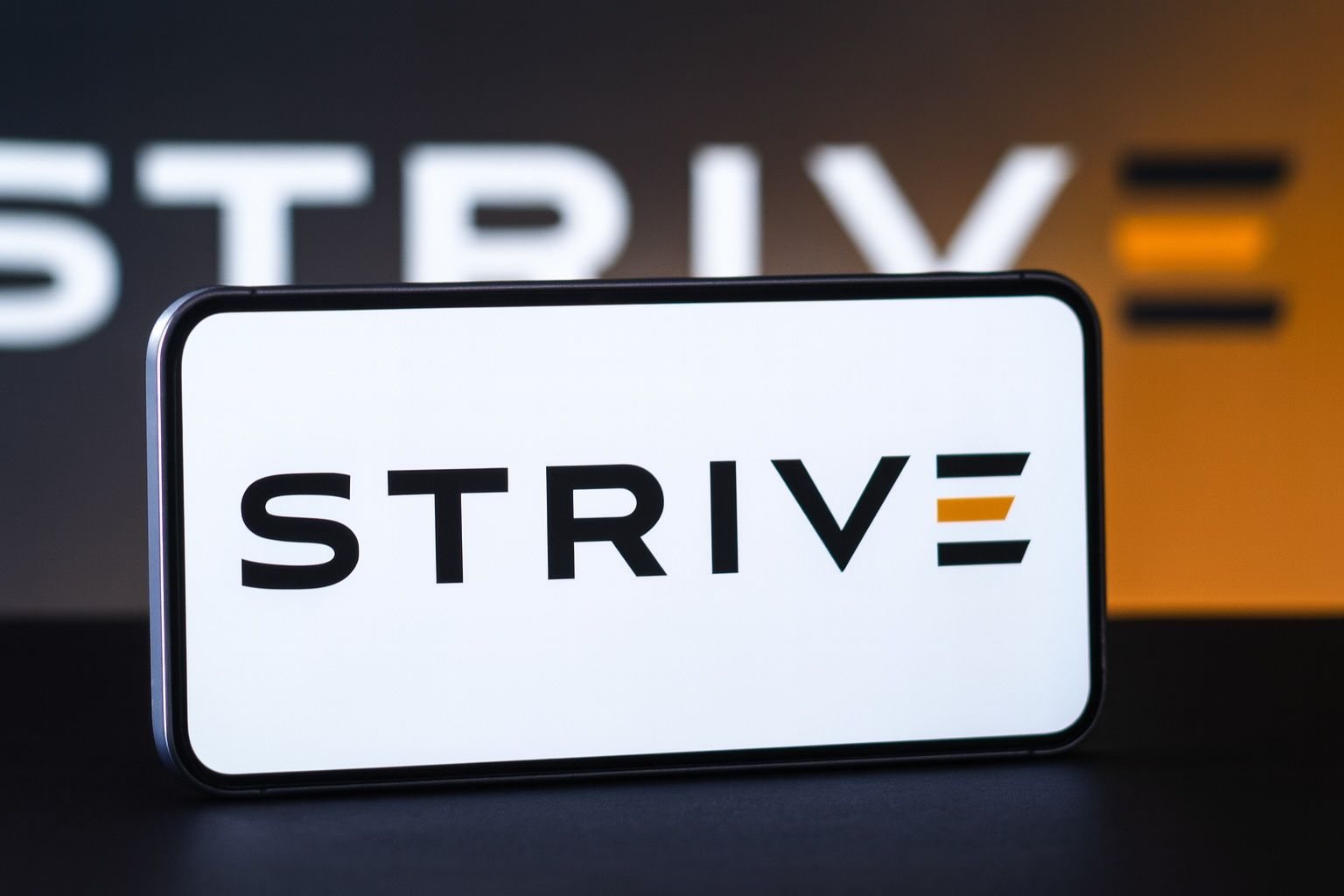- Strive (NASDAQ: ASST) surged as much as 40% overnight into Monday, Oct. 27, 2025, extending Friday’s 27% jump to a $1.10 close [1]. The stock is now up 124% year-to-date, marking a stunning rebound for the crypto-focused company.
- Bitcoin-fueled momentum: The Dallas-based firm – co-founded by Vivek Ramaswamy – has reinvented itself as a “Bitcoin treasury” company [2]. A broader crypto rally (Bitcoin just reclaimed $115,000 [3]) is lifting ASST alongside other crypto-linked stocks.
- Bold acquisitions: In recent weeks Strive announced a $1.34 billion all-stock merger with Semler Scientific (NASDAQ: SMLR), adding 5,816 Bitcoin (worth ~$675 million) to its balance sheet [4]. It also agreed to acquire True North, a Bitcoin media platform, and appointed veteran Ben Werkman as CIO to advance its crypto strategy [5]. These moves bring Strive’s holdings to nearly 11,000 BTC, aiming to “maximize Bitcoin per share” for investors [6].
- Whiplash volatility: Earlier this month, an Oct. 10 SEC filing to register 1.28 billion new shares for insiders spooked investors, triggering a 32% sell-off [7]. Analysts warn ASST can swing 4–5× more than Bitcoin’s price, amplifying gains and losses [8]. The stock is still down ~90% from its 2025 peak, underscoring the high-risk, high-reward nature of this crypto bet.
- Looking ahead:CEO Matt Cole calls the Semler deal “transformational,” claiming it cements Strive as a top corporate Bitcoin holder [9]. With earnings due Nov. 13 and no Wall Street price targets yet (major firms don’t cover it [10]), Strive’s fate is seen tied to Bitcoin’s trajectory. Bulls say its bold strategy could pay off if crypto stays hot, while skeptics note execution and crypto volatility remain key wildcards.
Stock Soars Amid Crypto Comeback
Strive, Inc. (ASST) stock is on a tear to start the week. By Monday morning (October 27, 2025), ASST shares had leapt roughly 25% in pre-market trading to about $1.37 [11], on track to add to Friday’s 27% surge. The stock closed last week at $1.10 after a big one-day jump [12], and briefly traded near $1.50 in overnight dealings – a 40% leap from Friday’s close [13]. This rapid rally has pushed Strive’s year-to-date gain above 120%, a remarkable turnaround for a stock that was languishing under $0.80 just days ago.
Investors appear energized by renewed bullish sentiment in crypto markets, which has lifted all boats tied to Bitcoin. Over the weekend, Bitcoin’s price rebounded above $115,000 [14] – a level not seen since earlier this month – after positive macro news bolstered risk appetite. Crypto-exposed stocks are following suit: market watchers note that Strive’s moves often correlate with Bitcoin’s, but at higher volatility. Indeed, ASST has effectively become a leveraged play on Bitcoin, sometimes moving “four to five times” as sharply as the cryptocurrency’s price swings [15]. That dynamic has been on full display in recent sessions: Strive’s share price, which plunged to $0.78 mid-last week, has now more than doubled in a few trading days, reflecting whiplash volatility in both directions.
Trading volume in ASST has been enormous throughout this rally, suggesting a mix of fast-money traders, short-covering, and speculative buying. On Friday alone, volume topped 247 million shares (far above normal) as the stock spiked over $1 for the first time in weeks [16]. This came after a prolonged slump: Strive’s stock had cratered by nearly 90% from its summer highs amid dilution fears and fading crypto euphoria [17]. Now, with Bitcoin climbing again and the company touting big new deals, some buyers are rushing in to bet the worst is over.
From Crash to Crypto Pivot: Strive’s Bold Transformation
Strive’s recent roller-coaster reflects its drastic strategic pivot this year. The company – formerly known as Asset Entities Inc. – completed a reverse merger in September to become “Strive, Inc.”, bringing aboard a team focused on cryptocurrency accumulation [18]. Notably, Strive was co-founded in 2022 by biotech entrepreneur and 2024 presidential candidate Vivek Ramaswamy, initially as an anti-ESG investment firm [19]. After going public via the Asset Entities tie-up, the firm swiftly reinvented itself as a Bitcoin holding vehicle, aiming to use public markets to raise capital and buy Bitcoin at scale.
The new strategy took shape through a series of blockbuster moves over the past two months. In mid-September, Strive announced an all-stock deal to acquire Semler Scientific, a California-based medical technology company, in a merger valued around $1.34 billion [20] [21]. The attraction wasn’t Semler’s healthcare business – it was Semler’s cash and crypto. As part of the agreement, Strive immediately purchased 5,816 Bitcoin (BTC) for $675 million, and the combined company will own more than 10,900 BTC in its treasury [22]. At current prices, that hoard is worth well over $1.2 billion, making Strive one of the world’s largest public holders of Bitcoin.
Strive’s CEO Matt Cole hailed the Semler merger as a “transformational” step that “cements Strive’s status among the top corporate holders of Bitcoin.” [23] He noted the deal accelerates their plan to grow Bitcoin reserves “at an unmatched pace” and deliver outsized “Bitcoin per share” gains to investors [24]. The Semler shareholders, for their part, got a rich premium (over 210% above market [25]) by accepting Strive stock – a sign of how aggressively Strive is willing to issue equity to acquire assets.
Just days before the Semler news, Strive also agreed to buy MSTR True North Inc., a Bitcoin-focused media and education platform with ties to MicroStrategy’s ecosystem. In that smaller deal (mostly stock with minimal cash), True North’s founder Jeff Walton joined Strive as Chief Risk Officer, and crypto veteran Ben Werkman (formerly of Swan Bitcoin) was appointed Chief Investment Officer [26]. These leadership additions bring crypto industry expertise in-house as Strive pursues what it calls an “alpha-generating Bitcoin accumulation” strategy [27]. Unlike simply buying and holding BTC (a “beta” play), Strive plans to acquire companies or assets that indirectly boost its Bitcoin holdings – for example, snapping up firms with large cash balances (to convert into BTC) or even distressed claims to crypto assets [28] [29]. The True North acquisition also gives Strive a built-in Bitcoin media arm (podcasts, events, and an audience of crypto enthusiasts), which can help promote its narrative and potentially attract investors [30].
Underpinning these moves is a war chest of new capital. Back in May, Strive raised $750 million in a private stock placement (with warrants that could bring in another $750M) to kick-start its Bitcoin buying spree [31]. The financing was done entirely through equity, not debt, reflecting management’s vow to avoid borrowing. Strive emphasizes its “preferred equity only” model – essentially funding growth by issuing shares rather than taking loans – to limit financial risk [32]. While that strategy has insulated the company from debt costs, it has a flipside: massive dilution for existing shareholders whenever new stock is issued. In fact, Strive’s share count has ballooned to roughly 689 million outstanding shares [33] after the recent deals – one reason the stock’s per-share price has dropped so steeply since summer.
Crypto Market Tailwinds and Sector Buzz
Strive’s high-stakes pivot comes at a fortuitous time: 2025 has seen a resurgence in crypto markets, and Bitcoin’s October rally has provided a strong tailwind. Over the weekend, Bitcoin surged to around $115,000 – rising on optimism about a potential U.S.–China trade deal and other macro hopes – bringing the cryptocurrency near its highest levels of the year [34] [35]. This broader uptrend has boosted sentiment for all Bitcoin-exposed stocks. For instance, industry bellwether MicroStrategy (now rebranded as Strategy, Inc.) saw its shares climb as Bitcoin regained six-figure prices; Marathon Digital Holdings, a leading Bitcoin miner, is trading around multi-year highs after a more than fivefold jump in 2025. Strive (ASST), as a newcomer in this space, is similarly riding the wave – but with an added dose of speculative excitement given its aggressive expansion moves.
Major financial media have taken notice of Strive’s emergence. Reuters recently described Strive as a “bitcoin-treasury company” and framed the Semler deal as part of “growing corporate adoption of bitcoin treasury strategies,” following the path blazed by Michael Saylor’s MicroStrategy [36]. In other words, Strive is joining a trend of companies converting corporate coffers into Bitcoin. What sets Strive apart is that it has no legacy business like software or mining – it’s positioning itself purely as a Bitcoin investment vehicle. “Strive says it is the first company on Nasdaq explicitly built around a Bitcoin treasury strategy,” notes one analysis [37]. By simply stockpiling BTC through mergers and investments, Strive’s model resembles a sort of “corporate Bitcoin ETF” [38]. Investors buying ASST shares are effectively getting indirect exposure to a large (and growing) pile of Bitcoin, managed by Strive’s team.
The company’s colorful backstory also adds to its media appeal. As mentioned, Strive was co-founded by Vivek Ramaswamy, who gained fame for his anti-ESG stance in finance and later his run for U.S. President. Ramaswamy left Strive’s board in early 2023 to pursue politics [39], but his involvement still draws attention to the stock. Finbold quipped that ASST is “a Vivek Ramaswamy stock” that just popped, tying the recent surge to the bold moves made by the firm he helped start [40]. This connection, along with Strive’s provocative mission to maximize Bitcoin holdings, has made the company a talking point well beyond typical penny-stock circles.
Analysts Sound Caution on “Wild” Stock Ride
Despite the excitement, market experts caution that Strive’s stock is not for the faint of heart. The events of early October served as a stark reminder of the risks. On October 10, Strive filed an SEC prospectus indicating plans to register 1.283 billion additional shares for resale by insiders [41] – essentially paving the way for early investors to sell stock. Importantly, Strive itself would not receive any cash from those sales, but the prospect of so much supply hitting the market sent the stock into a tailspin. ASST shares plunged 14% that day to around $1.55, then another ~32% after-hours to about $1.05 [42] [43]. By the following Monday, the stock was scraping multi-month lows near $0.90.
This episode highlighted the double-edged sword of Strive’s equity-funded strategy: while raising capital via stock sales enables big acquisitions, it can severely dilute existing shareholders and crush the share price. “Given the extreme volatility and dilution risk, most analysts would view Strive as highly speculative,” observes one research note [44]. No major Wall Street bank currently provides coverage or official price targets for ASST [45], likely due to its tiny pre-pivot revenue and unorthodox business model. Independent analysts who do follow the stock emphasize that Strive’s fortunes will largely track the price of Bitcoin and investor appetite for crypto exposure. “If Bitcoin rallies, Strive could amplify the gains by issuing shares to buy more crypto, but in a downturn its stock could fall faster than Bitcoin,” one analysis explains [46].
Even crypto-focused commentators urge caution. Adam McCarthy, an analyst at data firm Kaiko, notes that stocks like Strive are “volatility plays… leveraged exposures” to digital assets [47]. In practice, a modest 3% dip in BTC could translate to a 15%+ drop in ASST, as “amplifying both gains and losses” has been the norm [48]. Short-term traders may thrive in that volatility, but long-term investors could be whipsawed. Some skeptics go further: Kadan Stadelmann, a crypto veteran, has criticized the recent wave of Bitcoin-holding companies as “self-dealing, dressed up as capital deployment,” suggesting some management teams are hyping up their stocks with flashy crypto moves that mainly benefit insiders [49] [50].
Regulators are also keeping an eye on the trend. Reports say the SEC and FINRA have contacted over 200 firms about unusual trading activity ahead of crypto-treasury announcements [51]. This implies watchdogs are wary of possible insider trading or “buy the rumor, sell the news” schemes in this hot niche. Strive hasn’t been accused of anything improper, but the scrutiny underscores that the hype around Bitcoin-heavy stocks comes with oversight.
On the optimistic side, there are those who see Strive as a pioneer. Joe Palmisano of ConnectMoney calls Strive’s all-in Bitcoin push “a bold next phase” for corporate crypto adoption, aiming to exploit inefficiencies in crypto markets [52]. Some crypto investors even speculate that well-run “Bitcoin treasury” firms could become “the Berkshire Hathaways of their blockchains,” using large crypto reserves to backstop ambitious projects [53]. If Strive can successfully accumulate undervalued assets and ride Bitcoin’s long-term appreciation, its shareholders could, in theory, enjoy outsized returns relative to just holding BTC. Ryan Watkins, a blockchain venture capitalist, argues that companies like Strive might eventually be valued not just on their Bitcoin holdings, but on how cleverly they leverage those holdings – a bit like how MicroStrategy saw its stock explode by innovatively using corporate funds to buy Bitcoin [54].
For now, however, even bullish observers temper their enthusiasm with realism: Strive is essentially a start-up with a $750+ million market cap built on crypto speculation. Execution risk is high – the company must integrate its acquisitions (e.g. actually close the Semler merger, which still faces shareholder and regulatory approvals [55]), manage its huge new Bitcoin treasury securely, and eventually deliver real financial results from this strategy. Until then, ASST will likely trade more on narrative and Bitcoin’s price swings than fundamentals, making it a roller-coaster ride.
Outlook: High Stakes on the Horizon
Looking ahead, Strive’s next known catalyst is its Q3 earnings report on November 13, 2025, where investors hope to hear updates on the Semler merger timeline and Strive’s Bitcoin purchase plans. The actual earnings numbers may be less important (the legacy business was small), but any guidance or commentary from management will be closely parsed. Matt Cole and his team will have to convince shareholders that their dilution-heavy strategy can generate long-term value, not just headline-making deals. They’ve repeatedly stressed a goal to “drive sustained outperformance relative to Bitcoin” [56] – essentially promising that Strive’s active approach will beat a simple buy-and-hold of BTC. Delivering on that promise will require shrewd deal-making and perhaps a bit of luck with crypto market timing.
In the meantime, market sentiment will likely remain the main driver for ASST stock. If Bitcoin continues climbing toward new highs, Strive’s shares could see further explosive upside – the stock’s beta to BTC is so high that each leg up in crypto prices can attract momentum traders to ASST. Conversely, any sharp pullback in Bitcoin could quickly erode the recent gains. No analysts currently offer formal forecasts, but on forums and FinTech platforms some traders are tossing out short-term price targets north of $2 if Bitcoin’s rally extends. Such targets should be taken with a grain of salt given the unpredictable swings.
Bottom line: Strive (ASST) has rapidly transformed into one of 2025’s most intriguing – and volatile – stock stories. In a matter of weeks, it went from a collapsing micro-cap to a resurgent crypto player nearly touching a $1 billion market cap [57]. The company’s audacious Bitcoin bet and big-name backers have drawn comparisons to MicroStrategy’s bold playbook and captured the imagination of crypto bulls. But with extreme volatility, ongoing dilution, and no guarantee of execution success, Strive remains a high-risk, high-reward gamble. As one commentator put it, “success hinges on both crypto prices and execution” [58] – meaning that for ASST shareholders, the ride will likely stay bumpy. For now, the stock’s wild October rally has given beleaguered investors a glimmer of hope, placing Strive firmly in the spotlight as a bellwether of just how far – and how fast – the new Bitcoin treasury trend can go [59].
Sources: Financial news reports and press releases [60] [61] [62] [63]; analyst commentary from Finbold and TS2 [64] [65]; Reuters and Bloomberg coverage [66] [67]. (All linked sources retrieved October 27, 2025)
References
1. finbold.com, 2. finbold.com, 3. finbold.com, 4. www.reuters.com, 5. stockanalysis.com, 6. ts2.tech, 7. finbold.com, 8. finbold.com, 9. finbold.com, 10. ts2.tech, 11. stockanalysis.com, 12. stockanalysis.com, 13. finbold.com, 14. finbold.com, 15. finbold.com, 16. ts2.tech, 17. ts2.tech, 18. ts2.tech, 19. finbold.com, 20. www.reuters.com, 21. www.reuters.com, 22. www.reuters.com, 23. finbold.com, 24. ts2.tech, 25. www.reuters.com, 26. finbold.com, 27. ts2.tech, 28. ts2.tech, 29. ts2.tech, 30. ts2.tech, 31. ts2.tech, 32. ts2.tech, 33. stockanalysis.com, 34. cryptopotato.com, 35. cryptopotato.com, 36. www.reuters.com, 37. ts2.tech, 38. ts2.tech, 39. www.reuters.com, 40. finbold.com, 41. ts2.tech, 42. ts2.tech, 43. ts2.tech, 44. ts2.tech, 45. ts2.tech, 46. ts2.tech, 47. ts2.tech, 48. finbold.com, 49. ts2.tech, 50. ts2.tech, 51. ts2.tech, 52. ts2.tech, 53. ts2.tech, 54. ts2.tech, 55. www.marketbeat.com, 56. ts2.tech, 57. stockanalysis.com, 58. ts2.tech, 59. ts2.tech, 60. www.reuters.com, 61. finbold.com, 62. finbold.com, 63. ts2.tech, 64. finbold.com, 65. ts2.tech, 66. www.reuters.com, 67. ts2.tech










